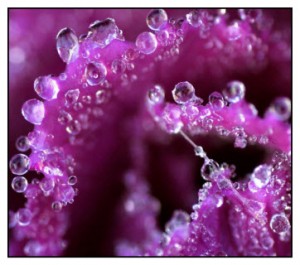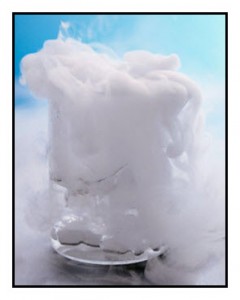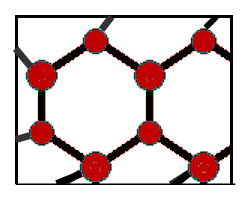What Happens When A Substance Gains or Loses Energy?
For this article, heat will be the energy source and water molecules the substance gaining or losing energy. So, what happens when water molecules gain or lose energy?
Energy is needed for motion, the more energy a substance has the faster is its motion. The reverse is also true, as energy is decreased, the motion of a substance decreases.
Before discussing the different changes in states of matter, you may wish to review the article, States of Matter, which describes what matter is.
Melting: Solid + Energy —-> Liquid
I will start with ice, the solid phase of water. In this phase, the motion of water molecules is more like a vibration instead of their zipping around from one place to another. The natural force of attraction between the the molecules holds them in a rigid hexagonal shape as shown in the drawing. Note that only one level of molecules is drawn. Actually, layers of these hexagonal cells attach to each other on all sides forming a three-dimensional structure.
The hexagonal shape of ice crystal units or cells gives snowflakes their six-sided shape. shape. In ice, six water molecules combine forming a hexagon. This is why snowflakes have a six-sided shape.
I’ll assume that the ice is at the freezing point of water, which is 32o F (0o C). When ice is heated, at first there is no temperature change. This is because temperature increases are due to an increase in the motion of molecules. Instead of moving faster, the molecules use the heat energy to break away from from the hexagonal structure they are in. Even when some of the water molecules are no longer part of the ice structure, they are still at 32 o F (0 o C). This is because as long as there is ice present, added energy goes to breaking the bonds in the hexagonal rings. The liquid water molecules do not move independently. But neither do they stay attached to specific water molecules as in ice. Instead, in less time than you measure–picoseconds–the water molecules form bonds between each other, break away and bond with other water molecules, and so on. Once all the ice melts, then any additional energy added causes the liquid water to increase in temperature.
Remember: This information is what is currently accepted as true but only a few years ago there was a different explanation. As technology improves, more accurate models are proposed. Scientists should always keep an open mind and NEVER dogmatically accept ideas. You may be the one to discover a better model for water’s different states of matter.
Freezing: Liquids – Energy ——-> Solid
Freezing is the opposite of Melting. Freezing occurs when a liquid loses energy. As energy is lost, molecules move slower, and the attractive force between like molecules (cohesion) pulls the molecules close and holds them in a relatively fixed position.
See States of Matter for instructions for kid-model of hexagonal ice crystal units.
Vaporization: Liquid + Energy———> Gas
Vaporization is the physical change of a liquid to a gas. An increase in energy can cause vaporization. Between water’s freezing point and boiling point, water molecules can vaporize, meaning the molecules change from a liquid state to a gas state.
Vaporization below the boiling point is called evaporation.
Evaporation occurs at the surface of water when heat from the air above the water is transferred to the surface water molecules. When a surface water molecule gains enough energy to break free from the bond it has with other water molecules around it, it moves upward and mixes with air. The single water molecule has more energy, moves independently and is a gas.
Vaporization at boiling point is called boiling.
Boiling occurs beneath the surface of water. Bubbles of water vapor form, rise to the surface and break through the surface layer of water. Just like in evaporation, the individual water molecules escape into the air. The difference is that these water molecules released at boiling point have more energy.
Condensation: Gas – Energy —–> Liquid
Condensation is the opposite of vaporization. Condensation occurs when a gas loses energy, slows in motion so that its cohesive force pulls the molecules close, but the molecules still have enough energy to break away from one connection only to connect with another molecule. There is constant movement as the water molecules cling and break away from each other.

Example: Water drop form on the outside surface of a glass containing ice water. The water drop form because water vapor in the air condense on the cold surface of the glass. The more humid the air, the more condensation.
Note: Condensation is the name of the process of a gas changing into a liquid. Condensation is also the term used for the liquid that forms.
Dew forms when water vapor in the air condenses on the cool outdoor surfaces, such as grass, flowers, cars, etc….The temperature at which dew forms is called dew point. Dew point is not a specific temperature, instead it depends on the amount of water in the air. Humidity is a measure of the amount of water in the air. An increase in humidity results in an increase in dew point.

Sublimation:
Solid + Energy ——–> Gas
Sublimation is the process by which a solid substances changes to a gas. The substance does not melt. Dry ice is a substance that sublimes. Dry ice is actually frozen carbon dioxide gas. Carbon dioxide freezes at -78o C. Not even your freezer can keep dry ice from subliming because the air in your freezer is much warmer than the solid dry ice.
The white smoke that appears around dry ice is actually a cloud of water droplets. As the frozen carbon dioxide sublimes, the carbon dioxide gas is so much colder than the water vapor in the air that the vapor condenses. The tiny water drops that form are just like those in clouds and fog as well as steam and your exhaled breath on a very cold day.
Deposition:
Gas – Energy———> Solid
Deposition is the reverse of sublimation. When a gas loses energy and changes directly to a solid without going through the liquid phase, it is called deposition.
The formation of frost is an example of deposition. For frost to form, surfaces have to be below the dew point temperature. This results in the atmospheric water vapor to change directly into a solid when it touches the cold surfaces.
NOTE: Frost is not frozen dew.
Big Book of Science Experiments
A book of fun informative experiments about astronomy, biology, chemistry, earth science, and physics.
(Paid Link)

